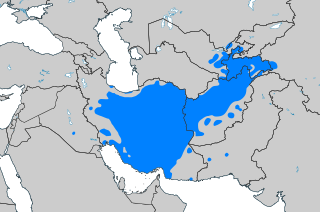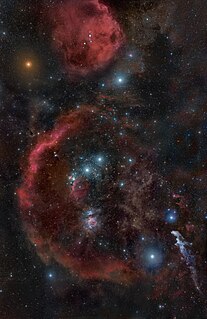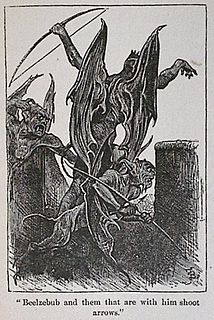
Excalibur is the legendary sword of King Arthur, sometimes also attributed with magical powers or associated with the rightful sovereignty of Britain. It was associated with the Arthurian legend very early on. Excalibur and the Sword in the Stone are in some versions said to be different, though in most incarnations they are the same. In Welsh, it is called Caledfwlch; in Cornish, Calesvol ; in Breton, Kaledvoulc'h; and in Latin, Caliburnus.

Persian, also known by its endonym Farsi, is a Western Iranian language belonging to the Iranian branch of the Indo-Iranian subdivision of the Indo-European languages. Persian is a pluricentric language predominantly spoken and used officially within Iran, Afghanistan and Tajikistan in three mutually intelligible standard varieties, namely Iranian Persian, Dari Persian and Tajiki Persian. It is also spoken natively in the Tajik variety by a significant population within Uzbekistan, as well as within other regions with a Persianate history in the cultural sphere of Greater Iran. It is written officially within Iran and Afghanistan in the Persian alphabet, a derivation of the Arabic script, and within Tajikistan in the Tajik alphabet, a derivation of Cyrillic.

King Arthur was a legendary British leader who, according to medieval histories and romances, led the defence of Britain against Saxon invaders in the late 5th and early 6th centuries. The details of Arthur's story are mainly composed of folklore and literary invention, and modern historians generally agree that he is unhistorical. The sparse historical background of Arthur is gleaned from various sources, including the Annales Cambriae, the Historia Brittonum, and the writings of Gildas. Arthur's name also occurs in early poetic sources such as Y Gododdin.

The periodic table, also known as the periodic table of elements, is a tabular display of the chemical elements, which are arranged by atomic number, electron configuration, and recurring chemical properties. The structure of the table shows periodic trends. The seven rows of the table, called periods, generally have metals on the left and nonmetals on the right. The columns, called groups, contain elements with similar chemical behaviours. Six groups have accepted names as well as assigned numbers: for example, group 17 elements are the halogens; and group 18 are the noble gases. Also displayed are four simple rectangular areas or blocks associated with the filling of different atomic orbitals.

The Picts were a group of Celtic-speaking peoples who lived in what is now northern and eastern Scotland during Late Antiquity and the Early Middle Ages. Where they lived and what their culture was like can be inferred from early medieval texts and Pictish stones. Their Latin name, Picti, appears in written records from the 3rd to the 10th century. Early medieval sources report the existence of a distinct Pictish language, which today is believed to have been an Insular Celtic language, closely related to the Brittonic spoken by the Britons who lived to the south.

Yahweh was the national god of the kingdoms of Israel (Samaria) and Judah, with origins reaching at least to the early Iron Age and apparently to the Late Bronze Age. In the oldest biblical literature he is a storm-and-warrior deity who leads the heavenly army against Israel's enemies; at that time the Israelites worshipped him alongside a variety of Canaanite gods and goddesses, including El, Asherah and Baal, but in later centuries El and Yahweh became conflated and El-linked epithets such as El Shaddai came to be applied to Yahweh alone, and other gods and goddesses such as Baal and Asherah were absorbed into the Yahwistic religion.

Henry V, also called Henry of Monmouth, was King of England from 1413 until his death in 1422. Despite his relatively short reign, Henry's outstanding military successes in the Hundred Years' War against France made England one of the strongest military powers in Europe. Immortalised in Shakespeare's "Henriad" plays, Henry is known and celebrated as one of the greatest warrior kings of medieval England.

An eponym is a person, place, or thing after whom or which someone or something is, or is believed to be, named. The adjectives derived from eponym include eponymous and eponymic.
A crore (; abbreviated cr), (Hindi: करोड़, karōṛa) denotes ten million (10,000,000 or 107 in scientific notation) and is equal to 100 lakh in the Indian numbering system. It is written as 1,00,00,000 with the local 2,2,3 style of digit group separators (one lakh is equal to one hundred thousand, and is written as 1,00,000).
The Lesser Key of Solomon, also known as Clavicula Salomonis Regis or Lemegeton, is an anonymous grimoire on demonology. It was compiled in the mid-17th century, mostly from materials a couple of centuries older. It is divided into five books—the Ars Goetia, Ars Theurgia-Goetia, Ars Paulina, Ars Almadel, and Ars Notoria.

Eddie Asner, known generally as Ed Asner and sometimes Edward Asner, is an American actor, voice artist, and a former president of the Screen Actors Guild. He is perhaps best known for his role as Lou Grant during the 1970s and early 1980s, on both The Mary Tyler Moore Show and its spin-off series Lou Grant, making him one of the few television actors to portray the same character in both a comedy and a drama. He is the most honored male performer in the history of the Primetime Emmy Awards, having won seven – five for portraying Lou Grant. His other Emmys were for performances in two of the most significant mini-television series of the 1970s: Rich Man, Poor Man (1976), where he won for Outstanding Lead Actor for a Single Performance in a TV series, and Roots (1977), for which he won for Outstanding Single Performance by a Supporting Actor in a TV series.

New Zealand is an island country in the southwestern Pacific Ocean. It consists of two main landmasses—the North Island and the South Island —and more than 700 smaller islands, covering a total area of 268,021 square kilometres (103,500 sq mi). New Zealand is about 2,000 kilometres (1,200 mi) east of Australia across the Tasman Sea and 1,000 kilometres (600 mi) south of the islands of New Caledonia, Fiji, and Tonga. The country's varied topography and sharp mountain peaks, including the Southern Alps, owe much to tectonic uplift and volcanic eruptions. New Zealand's capital city is Wellington, and its most populous city is Auckland.

Beelzebub or Beelzebul is a name derived from a Philistine god, formerly worshipped in Ekron, and later adopted by some Abrahamic religions as a major demon. The name Beelzebub is associated with the Canaanite god Baal.
Prosystenus is an extinct genus of fly in the family Dolichopodidae. It contains only one species, Prosystenus zherichini, from the Eocene of Russia.

Edward Christopher Sheeran is an English singer, songwriter, musician, record producer, actor, and businessman. After first recording music in 2004, he began gaining attention through YouTube. In early 2011, Sheeran independently released the extended play, No. 5 Collaborations Project. He signed with Asylum Records the same year.
Parathalassiinae is a subfamily of flies in the family Dolichopodidae. It is part of an expanded concept of the family, Dolichopodidae sensu lato, and forms a monophyletic group with Dolichopodidae sensu stricto. It was once placed provisionally in the subfamily Microphorinae as the tribe Parathalassiini.
Cretomicrophorus is an extinct genus of flies in the family Dolichopodidae from the Cretaceous of Russia, France and the United States. The generic name is a combination of the Latin word creta ("chalk") and the generic name Microphorus.
Archichrysotus is an extinct genus of flies in the family Dolichopodidae. The generic name is a combination of the Greek prefix archi- and the generic name Chrysotus. The genus is known from Upper Cretaceous amber from the Taymyr Peninsula in Russia, New Jersey in the United States and Manitoba in Canada.












